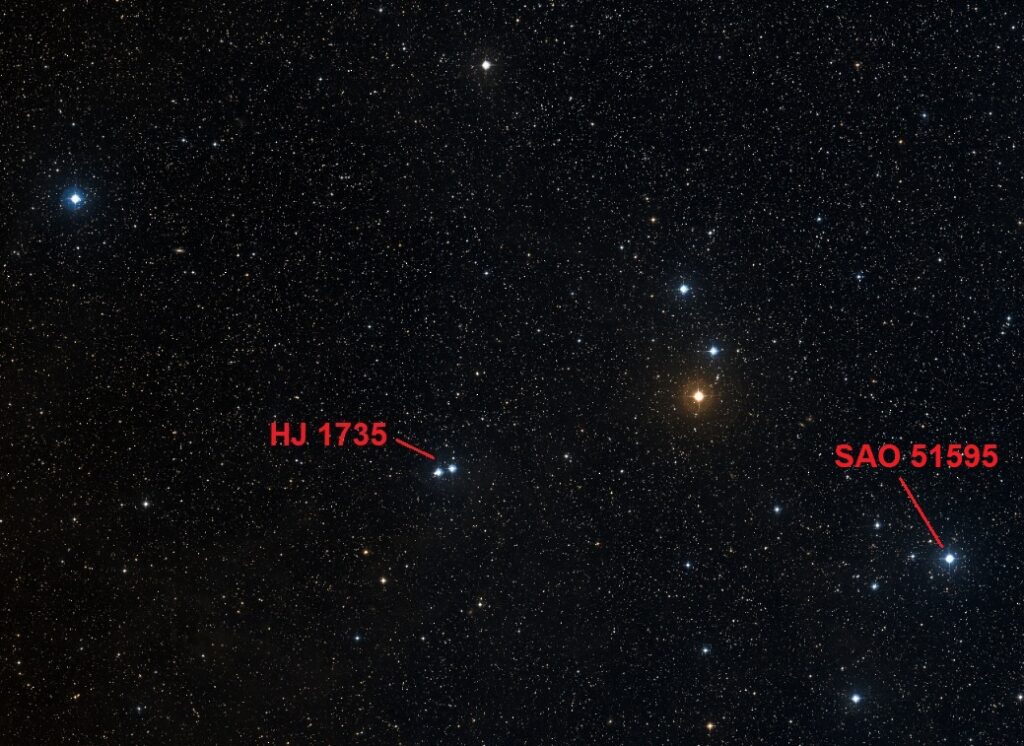A list of the least observed constellations in northern skies would surely include Lacerta the Lizard, added to the celestial canon by Johannes Hevelius in 1687. Maybe THE least observed? How could that be determined, I wonder? 🤔The above image is a detail from Plate 11 of Alexander Jamieson’s Celestial Atlas published in 1822 (courtesy of Wikimedia). Jamieson’s depiction includes additional stars (now on permanent loan from the constellation Cepheus) but not part of Lacerta as originally depicted in the Firmamentum Sobiescianum, the celestial atlas created by Hevelius, published posthumously in 1690. Hevelius said of the lizard that nothing larger would fit in the space. Additional details and an image of the original constellation conceived by Hevelius can be found on Ian Ridpath’s superb website devoted to celestial atlases.

This striking binocular asterism is on Lacerta’s western border (with Cygnus). I am apt to view it when roaming the skies around the open cluster M 39 in Cygnus. It includes the superb binocular double star HJ 1735, which is wide enough to be resolved with handheld binoculars, though more enjoyable to me with a mounted binocular.
HJ 1735
22h09m +44*51′
AD 6.73/6.77 sep 110.16″ pa 285.6*
Distance: 921.53 / 982.75 LY
Spectral Type: B9IV / A0
Color Index: -0.037 blue-white / -0.043 blue-white
On Monday evening (9 October 2023) I met a frequent dark sky observing companion, Bill Barlow, at Lewis-Young park in Louisburg, Kansas for an evening of astronomy, which included viewing Lacerta naked-eye. It can’t be seen from my urban yard without binoculars. It is a quite small, as Hevelius stated, but fun nevertheless. It is sometimes called the Little Cassiopeia because part of its main asterism forms a “W” reminiscent of the more prominent Cassiopeia asterism (which is nearby). I’m not sure I have intentionally observed the constellation of Lacerta before. If I have done so, it has been many, many years since. It was fun to view and worth the 30 minute drive, apart from other fine deep sky views I enjoyed during the evening with the Oberwerk 100XL-SD on a Manfrotto 475B tripod along with a bevy of binocular traveling companions. 😉
When I first arrived I was surprised to find dozens of cars where Bill and I set up for observing, a consequence of impromptu overflow soccer fields immediately to the west. The main soccer field in the park, which is lighted(!) 🤨is fortunately well to the northwest, behind a thick line of trees, but rather less fortunately adjacent to the Astronomical Society of Kansas City’s Powell observatory. I wondered if Bill might have decided to set up by the observatory (the building can be used to block the soccer field lights), so I drove over to the observatory and waited for 5 minutes or so. But when Bill, who is quite punctual, did not show up I thought he might be at our customary location wondering where I was so I drove back over, only to find that he had arrived in my absence and was setting up his telescope amidst all of the soccer family cars, with remarkable aplomb. 😁The soccer games concluded in early twilight and the families departed, leaving the field and stars to Bill and me.
More binocular fun and frolic in Lacerta on the way…


Lacerta is certainly one of my most neglected constellations, Fiske. I need to rectify that. Glad you and Bill finally met up for your observing session. I love his sangfroid 🙂
Sangfroid! Wonderful word, Dale. Thank you! And that is Bill to the nth degree. 😉
It occurs to me that the MoonStar 6.5×32 might be an ideal binocular for viewing Lacerta in urban skies like ours. Will have to give that a try. Not to mention the Oberwerk 8×32 SE. 🤔 A wide-field urban binocular duel in Lacerta might be in the offing…
That’s an outstanding idea! I’m in here for that wide-field urban binocular “duel” in Lacerta, once our skies clear.
You say Lacerta is neglected, but Gloria Frederici right next to it is on a whole other level.
That being said, I do drop by occasionally (if only to starhop to NGC 7662 in Andromeda next door).
It’s a date. 😉
You’ve got a point there, Columbidae. I’m not sure I have observed any extinct constellations — I mean to view Bufo the Toad after reading Phil Harrington’s Binocular Universe column about it. Gloria Frederica is a fine addition to the extinct constellation list. Thank you! 😊
Here is a recent observation of NGC 7662, aka the Blue Snowball, which I also navigated to from Lacerta. 😉
Spent a little time in Lacerta last night with my 20x70s – the highlights of the night were a pair of opposites: NGC 7209 and NGC 7243. They might not jump out at Bortle 6/7 but are nice regardless.
Double stars: STF 2922 (not sure if I saw C), STF 2894 (just A+B), and HJ 975 (a nice mag diff pair).